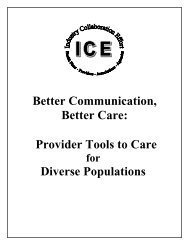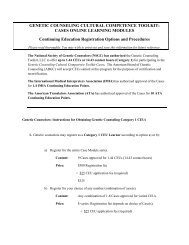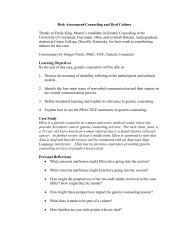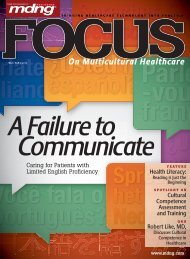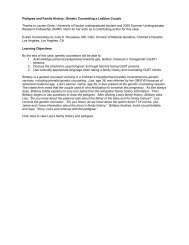Advanced Effective Communication, Cultural Competence, and ...
Advanced Effective Communication, Cultural Competence, and ...
Advanced Effective Communication, Cultural Competence, and ...
You also want an ePaper? Increase the reach of your titles
YUMPU automatically turns print PDFs into web optimized ePapers that Google loves.
A Roadmap for Hospitals<br />
Chapter Six: Organization Readiness<br />
http://www.qualityforum.org/Publications/2009/04/A_<br />
Comprehensive_Framework_<strong>and</strong>_Preferred_Practices_for_<br />
Measuring_<strong>and</strong>_Reporting_<strong>Cultural</strong>_Competency.aspx. (Accessed<br />
March 2, 2010.)<br />
4. NRC Picker: Eight Dimensions of Patient-Centered Care. Lincoln,<br />
NE: National Research Center, 2008. Available at<br />
http://www.nrcpicker.com/Measurement/Underst<strong>and</strong>ing%20<br />
PCC/Pages/Dimensions ofPatient-CenteredCare.aspx. (Accessed<br />
October 24, 2008.)<br />
13. Andrulis D., et al.: The <strong>Cultural</strong> <strong>Competence</strong> Self-Assessment Protocol<br />
for Health Care Organizations <strong>and</strong> Systems. 2004. Available at<br />
http://erc.msh.org/provider/<strong>and</strong>rulis.pdf. (Accessed March 3, 2010.)<br />
14. Adaptive Environments Center, Inc., Barrier Free Environments,<br />
Inc.: The Americans with Disabilities Act Checklist for Readily<br />
Achievable Barrier Removal. Boston, MA: Adaptive Environments<br />
Center, Inc., Barrier Free Environments, 1995. Available at<br />
http://www.ada.gov/checktxt.htm or http://www.ada.gov/<br />
racheck.pdf. (Accessed March 2, 2010.)<br />
5. Davis K., Schoenbaum S.C., Audet A.J.: A 2020 vision of patientcentered<br />
primary care. J Gen Intern Med 20(10):953-957, Oct. 2005.<br />
6. Planetree: Planetree Model–Acute-Care. Acute Care Components.<br />
Derby, CT: Planetree, Inc., 2008. Available at http://planetree.org/<br />
about.html. (Accessed October 24, 2008.)<br />
7. American Hospital Association (AHA): AHA Guidance on Reporting<br />
of Community Benefit. Chicago, IL: AHA, 2006. Available at<br />
http://www.aha.org/aha/content/2006/pdf/061113cbreporting.pdf.<br />
(Accessed March 2, 2010.)<br />
8. Office of Minority Health: National St<strong>and</strong>ards on <strong>Cultural</strong>ly <strong>and</strong><br />
Linguistically Appropriate Services in Health Care: Rockville, MD:<br />
U.S. Department of Health <strong>and</strong> Human Services, Office of Minority<br />
Health, 2001.<br />
15. Delpercio A: Healthcare Equality Index 2009. Washington, DC:<br />
Human Rights Campaign Foundation <strong>and</strong> Gay <strong>and</strong> Lesbian Medical<br />
Association, 2009. Available at http://www.hrc.org/documents/<br />
Healthcare_Equality_Index_2009.pdf. Accessed March 2, 2010.<br />
16. White S., Dillow S.: Key Concepts <strong>and</strong> Features of the 2003 National<br />
Assessment of Adult Literacy. Washington, DC: National Center for<br />
Education Statistics, U.S. Department of Education, 2005. Available<br />
at http://nces.ed.gov/NAAL/PDF/2006471.PDF. (Accessed<br />
April 15, 2010.)<br />
17. Ulmer C., McFadden B., Nerenz D.: Race, Ethnicity, <strong>and</strong> Language<br />
Data: St<strong>and</strong>ardization for Health Care Quality Improvement. Washington,<br />
DC: The National Academies Press, 2009. Available at<br />
http://books.nap.edu/openbook.php?record_id=12696. (Accessed<br />
April 9, 2010.)<br />
9. Wilson-Stronks A., et al.: One Size Does Not Fit All: Meeting The<br />
Health Care Needs of Diverse Populations. Oakbrook Terrace, IL:<br />
Joint Commission on Accreditation of Healthcare Organizations,<br />
2008. Available at http://www.jointcommission.org/PatientSafety/<br />
HLC/one_size_meeting_need_of_diverse_populations.htm.<br />
(Accessed April 9, 2010.)<br />
10. The Ethical Force Program: Advancing Ethics in Health Care.<br />
http://www.ethicalforce.org. (Accessed May 21, 2010.)<br />
11. Wynia M.K., et al.: Validation of an organizational communication<br />
climate assessment tool. Am J Med Qual. May 5, 2010 Online First.<br />
Available at http://ajm.sagepub.com/cgi/rapidpdf/<br />
1062860610368428v1. (Accessed May 13, 2010.)<br />
12. Frampton S., et al.: Patient-Centered Care Improvement Guide.<br />
Derby, CT: Planetree, Inc., <strong>and</strong> Picker Institute, 2008. Available at<br />
http://www.planetree.org/Patient-Centered%20Care%20Improvement%20Guide%2010.10.08.pdf.<br />
(Accessed March 1, 2010.)<br />
18. Hasnain-Wynia R., et al.: Health Research <strong>and</strong> Educational Trust<br />
Disparities Toolkit. Chicago, IL: Health Research & Educational<br />
Trust, 2007. Available at http://www.hretdisparities.org. (Accessed<br />
March 2, 2010.)<br />
19. The Schwartz Center: Schwartz Center Rounds ® Toolkit. Boston,<br />
MA: The Schwartz Center, 2008. Available at http://www.theschwartz<br />
center.org/programs/rounds_kit.html. (Accessed March 2, 2010.)<br />
20. The Center for Universal Design: The Principles of Universal Design,<br />
Version 2.1. Raleigh, NC: North Carolina State University, 1997.<br />
Available at http://www.design.ncsu.edu/cud/about_ud/ud<br />
principleshtmlformat.html. (Accessed on March 2, 2010.)<br />
21. Partnership for Clear Health <strong>Communication</strong>: Ask Me 3: What<br />
Can Providers Do? Boston: National Patient Safety Foundation,<br />
2009. Available at http://www.npsf.org/askme3/PCHC/<br />
what_can_provid.php. (Accessed March 1, 2010.)<br />
44



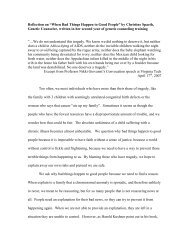
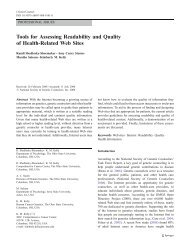

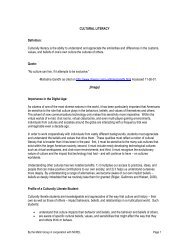
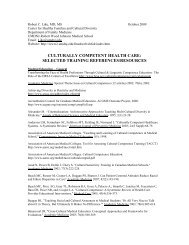

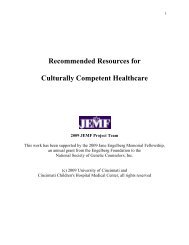

![Breaking Bad News PPT[1] - Genetic Counseling Cultural ...](https://img.yumpu.com/35003134/1/190x146/breaking-bad-news-ppt1-genetic-counseling-cultural-.jpg?quality=85)
